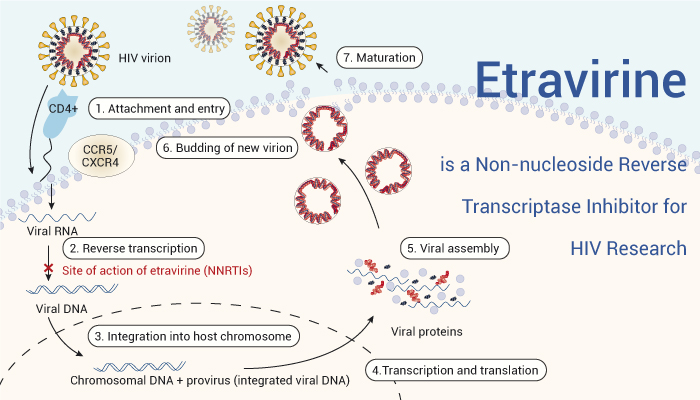Nucleoside reverse transcriptase inhibitors (NRTIs) block reverse transcriptase (an HIV enzyme). Non-nucleoside reverse transcriptase inhibitors (NNRTIs) bind to and block HIV reverse transcriptase. HIV uses reverse transcriptase to convert its RNA into DNA (reverse transcription). Blocking reverse transcriptase and reverse transcription prevents HIV from replicating.
HIV (Human immunodeficiency virus) is a lentivirus (a subgroup of retrovirus). And it causes the acquired immunodeficiency syndrome (AIDS). This disease is a progressive failure of the immune system allows life-threatening opportunistic infections and cancers to thrive.
Infection with HIV occurs by the transfer of blood, semen, vaginal fluid, pre-ejaculate, or breast milk. Within these bodily fluids, HIV is present as both free virus particles and virus within infected immune cells. HIV infects vital cells in the human immune system such as helper T cells (specifically CD4+ T cells), macrophages, and dendritic cells. HIV infection leads to low levels of CD4+ T cells through a number of mechanisms, including apoptosis of uninfected bystander cells, direct viral killing of infected cells, and killing of infected CD4+ T cells by CD8 cytotoxic lymphocytes that recognize infected cells. When CD4+ T cell numbers decline below a critical level, cell-mediated immunity is lost, and the body becomes progressively more susceptible to opportunistic infections.
Etravirine is a Non-nucleoside Reverse Transcriptase Inhibitor for HIV Research
Etravirine (R165335; TMC125) is a non-nucleoside reverse transcriptase inhibitor (NNRTI). And it can be used in HIV research. In Vitro, TMC125 is highly active against wild-type HIV-1 ( EC50=1.4 to 4.8 nM) and shows some activity against HIV-2 (EC50=3.5 μM). TMC125 also inhibits a series of HIV-1 group M subtypes and circulating recombinant forms and a group O virus. TMC125 has activity for 19 viruses with EC50 of < 5 nM. In conclusion, Etravirine is a non-nucleoside reverse transcriptase inhibitor (NNRTI) and can be used in HIV research.
Reference:
[1]. Antimicrob Agents Chemother, 2004. 48(12): p. 468
